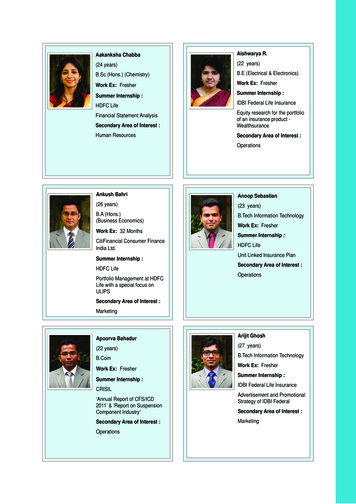
Transcription
-i HDFCRef. No. SE/ 2020-21/299HOUSING DEVELOPMENT FINANCE CORPORATION LIMITEDwww.hdfc.comFebruary 4, 2021BSE LimitedP. J. Towers,Dalal Street,Mumbai 400 00 I.National Stock Exchange of India LimitedExchange Plaza, Plot No. C/1, Block G,Bandra-Kurla Complex, Bandra (East)Mumbai 400 051.Kind Attn: - Sr. General ManagerDCS - Listing DepartmentKind Attn: Head - ListingDear Sirs,Sub:Publication of Notice in newspapers containing un-audited financial results ofthe Corporation for the quarter/nine-months ended December 31, 2020Pursuant to the captioned subject, please find enclosed herewith copies of newspaperclippings published by the Corporation.The said newspaper clippings are also available on website of the Corporation,www.hdfc.comThis is for your information and record.Thank you,Yours faithfully,For ousing Development Finance Corporation LimitedEncl: a/aCorporate Office: HDFC House,HT Parekh Marg,165-166, Backbay Reclamation,Churchgate,Mumbai 400 020.Regd. Office:Tel.: 66316000,22820282.Fax:022-22046834,22046758.Ramon House,HT Parekh Marg, 169,Backbay Reclamation,Churchgate, Mumbai 400 020. INDIA.Corporate Identity Number: L70100MHI 977PLC0! 9916
Business StandardTAKE TWO 9MUMBAI WEDNESDAY, 3 FEBRUARY 2021 .The call of 5GThe Big Two telecom companies haveaccelerated their moves towards this next-gentechnology, though they have chosen verydifferent routes to getting thereSURAJEET DAS GUPTANew Delhi, 2 FebruaryThe battle for 5G is suddenly hottingup. In an unexpected move lastweek, Bharti Airtel announced that ithad become the first telco to demonstratelive non-standalone 5G service over its commercial network in Hyderabad, using existing spectrum in the 1,800 band. And on thesame day communications minister RaviShankar Prasad extolled the fact that the 5Gcore (the heart of the network) should bemade in India and said his ministry wouldsoon give the much delayed permission fortrial runs of the technology.The Airtel move comes just a fewmonths after Reliance Jio quietly tested itsown indigenously designed standalone 5Gradio and core far way in the US on aVerizon 5G live network (its application for3,500 and millimetre band spectrum fortesting in India is pending). Reliance, however, declined to talk about it. During itsinvestor presentation on its quarterly resultsa few days ago, the company announcedthat its indigenous core and radio hasachieved throughputs of 1 GBPS or nearly 10times the highest speeds for 4G.Analysts say Airtel’s decision to showcase its 5G prowess was mainly to allay concerns that it might trail Reliance Jio in the5G preparedness game. After all, in the 4Gspace, Airtel was the first to launch the service in the country in 2012 but could notleverage its first-mover advantage, mainlybecause it was unable to anticipate Jio’sdisruptive entry four years later.The concerns about Airtel’s 5G readiness came out in the open a few weeks agowhen Sunil Mittal stated at the IndianMobile Congress that 5G is two to threeyears away in India. Yet at the same forumMukesh Ambani created a stir when hesaid Jio was ready to launch 5G services inthe second half of this year, once spectrumwas auctioned.To be sure, despite all the noise of Indiataking the lead in 5G, it is already behind thecurve. As much as 15 per cent of the globalpopulation already has 5G coverage and bythe end of 2020 there were 200 million cus-DECODING 5GTECHNOLOGIES NON-STANDALONEIt’s an interim architecture that enablesoperators to leverage their existinginvestments in their 4G LTE networksand core, and reduce capital costs.Although it offers higher speeds and isgood for offering last-mile wirelessmobile broadband to homes, severalnew and lucrative services cannot beenabled on this platform. Airtel usedthis technology. STANDALONEIn this, a network has to be built with anew 5G core and new radios thatwork on 5G bands. It offers lowlatency, which only can powermachine-to-machine operation,enable automation, remote roboticsurgery, autonomous vehicles and bethe backbone for building smart cities.Jio used this technology. WHO HAS ADOPTED WHATGlobally, most networks arenon-standalone, but Singapore,China and South Korea are usingstandalone. By the end of this year,many more will join in.tomers and 113 operators across the globeoffering 5G services.The four key things required to power5G services are: Auction of adequate spectrum in the 3500 and millimetre bands like26-28 GHZ bands; a 5G devices ecosystemand their availability at affordable prices;cash flows with telcos to invest in the highspeed network; and appropriate technology such as leveraging open radio networks(known as O-RAN) which will help reducecosts and allow for faster rollouts.Both Jio and Airtel are betting onO-RAN-based technology, which allowsoperators the choice to buy software andhardware from an array of vendors and integrate them rather than depend only on afew gear makers such as Nokia or Ericson.The new approach reduces capital (saving of 40 per cent) and operating costs (byover 35 per cent), enables faster rollout (astechnology is more software loaded whichcan be remotely upgraded rather thanhardware dependent), and offers flexibility in telecom network management.But beyond that, the two have very different approaches.Jio’s approach has been to build anindigenous network based on 5G radioand the core by its in house R&D — whichis writing the software, designing theproducts and even plans to manufacturehardware on its own or through third-party players. Jio will have its own team forsystem integration. It hopes to offer thisend-to-end architecture to other competing global operators and make it a newbusiness opportunity.Bharti’s approach is one of collaboration. “We want to get the best quality andthe lowest cost for our networks. We arenot looking at becoming an R&D providerfor the world,” said a senior executive ofthe company.So Bharti has tied the knot for technology with a bevy of players — Japanesehardware giant NEC, Taiwanese majorSercomm, cloud player Red Hat in the US,and Texas-based start-up Mavenir — tobuild the network. It is also working closely with US-based Altiostar (which has beenbought over by Japanese telco Rakuten) tohelp build the virtual software architecture as well as co-design software withthem. And it is open to tying up traditional gear makers, which are also looking atreorienting their business models to meetnew realities.But the consensus is with the high levelsof software in the network, rollout time hasgot squeezed dramatically. In China, telcoslaunched 5G in over 50 cities in only fivemonths. In India, they expect to roll out incentral business districts of large cities within six months of getting spectrum and 18-24months across the country.Gear makers said telcos have to spendanything between 7 billion and 10 billionto roll out a standalone 5G network (withoutspectrum) across the country. And bothAirtel and Jio have the financial muscle todo so. However, given that it has fewer towers and fibre than Jio, Bharti’s investmentswould be on the higher side. Also, Jio’s parent RIL, which has a debt-free balancesheet, will find it easier to finance the rollout than its rival.The more important issue would bewhen, how much and at what base price thegovernment will offer 5G spectrum in the3,500 band. Telcos have said that calculated on the basis of the base price they haveto fork out 3.63 trillion together, which istoo high and they will not participate untilit is reduced. The government has notbudged but it might be looking at a longerstaggered payment scheme. The good newsis that discussions are in the final stages ingovernment on resolving the competingdemands of defence and space, whichtogether hold 125 Mhz in this band and haverefused to shift out. Without this, therewon’t be enough spectrum (175 MHz) forthree or even two 5G players (a minimum100 MHz is required for 5G).At the user end, the prices of 5Gmobile devices are set to fall this year.They are already 18 5G models in themarket and Qualcomm predicts that bythe end of 2021, 60-70 per cent of thesmartphones sold in India will be 5Genabled. And with new more cost effective chipset, prices of 5G phones would bebetween 10,000 and 15,000 pretty soon.The ground is rapidly being created forthe next big technology battle.ON THE JOBNot a Budget for employmentMAHESH VYASThe government of India does notrecognise any employment problem in the country. Two important statements it made related to theeconomic situation in the country overthe last four days — the Economic Surveyand the finance minister’s speech — didnot recognise, in any manner, the factthat scores of millions of Indians lostlivelihoods in 2020-21. Most people foundways to reduce their misery with or without help from the government. The government does not recognise this phenomenon and therefore it does notdirectly address it in the two documentsreleased by it recently.The finance minister’s speech contained no specific scheme to help theunemployed or to generate employmentdirectly. Hopes of an urban version ofthe MGNREGA were belied. The financeminister did not mention MGNREGA inher speech. The scheme was a major saviour of employment in rural India duringthe lockdown. Budgetary allocation forthe scheme was raised from 615 billionto 1,015 billion because of the lockdownand the need to provide employment.The revised estimate is raised further to 1.115 billion. The budgetary allocationfor the scheme in 2021-22 is 730 billion.A scheme to promote textiles proposed by the finance minister could generate employment. The government proposes to set up seven Mega InvestmentsTextiles Parks (MITRA) over three years.Textiles is the largest manufacturing sec-tor employer in India. Even if this scheme reach 400.7 million. This is the first timeis successful, it is unlikely to move the since the lockdown that employmentneedle on employment much. Similarly, crossed the 400-million mark. Thethe higher allocation for roads or housing increase in employment in January isis unlikely to make a material difference concentrated in the construction and into employment. The challenges on the agriculture sectors. Employment in conemployment front are much bigger.struction increased by 8.6 million — fromBudget documents presented in 62.1 million in December 2020 to 70.7Parliament on Monday tell us that central million in January 2021. The growth ingovernment employment would be 3.41 employment in agriculture was relativemillion in 2020-21. This implies a 3.4 per ly modest at 4.2 million. It increased fromcent growth in central government 144.9 million to 149.1 million over theemployment over the 3.31 million it same period.The manufacturing sector saw a maremployed in 2019-20. But, last year’sBudget documents of the government ginal improvement in employment fromhad told us that employment in 2019-20 29.3 million to 29.7 million. Services induswould be 3.62 million. So, the government tries saw a fall in employment during thishas revised its employment estimate of period. Some of these monthly changes2019-20 down by about 310,000. Interest- reflect seasonality and also the monthlyingly, last year, they said that the employ- changes in the sample. Because of thement in 2018-19 was 3.49 milhighly disruptive nature of ecolion. But now they tell us that Compared tonomic growth in recent yearsemployment then was 220,000 a year ago,for a variety of reasons, decilesser at 3.27 million. So, the employment in phering the seasonal compoemployment in 2020-21 at 3.41 January 2020nents of growth is not possible.million would be lower than was lower byA year-on-year comparisonhelps overcome both problems.what they said the employment 9.8 millionwas three years earlier in 2018-19Because of the panel nature ofat 3.49 million. This is if the estimate for CMIE’s Consumer Pyramids HouseholdSurvey, the sample of January 2020 is the2020-21 is not revised downwards.Historical data tell us that central gov- same as it was in January 2019.Compared to a year ago, employmenternment employment has been stable atabout 3.3 million since at least 2000-01 in January 2020 was lower by 9.8 milwhen it was at this level. The average lion. The sector-wise breakup shows thatemployment in the 19 years, from 2000- the employment grew in agriculture and01 through 2018-19, has been 3.26 mil- it fell in industry and services. It grew inlion in a year. Central government agriculture by 10.6 million but it fell byemployment maxed at 3.42 million in 14.3 million in manufacturing and by 10.12001-02 and was at its lowest of 3.15 mil- million in services.It is important to increase employlion in 2011-12. The last five “final” estimates of 2012-13 through 2018-19 show a ment in general. It is even better tosteadily declining trend of central gov- increase good quality jobs. Strategically,ernment employment. Given this his- it is important to move people from farmstorical record, the projection of employ- to factories to improve overall labour proment of 3.4 million in 2020-21 and 3.3 ductivity. It is important to improve jobmillion in 2019-10 seem like tall claims. opportunities for women, for urbanitesMeanwhile, labour markets recovered and for the educated. The Budget doesin January 2021 from the setback they not contain ideas to do any of this.suffered in December 2020. Employmentincreased by 11.9 million in January to The writer is MD and CEO, CMIE P LtdHDFCUNAUDITED CONSOLIDATED FINANCIAL RESULTS FOR THEQUARTER AND NINE MONTHS ENDED DECEMBER 31, 2020tin CrorePARTICULARSQuarter endedDecember 31, 2020Nine months endedDecember 31, 2020Quarter endedDecember 31, 2019ReviewedTotal Income from operations (net)39,259.061,03,295.6029,071.96Net Profit for the period(before tax and Extraordinary items)6,810.7717,533.004,600.79Net Profit for the period before tax(after Extraordinary items)6,810.7717,533.004,600.79Net Profit for the period after tax(after Extraordinary items)5,724.2314,818.174,196.48Christie’s arm enters India asluxury real estate growsTotal Comprehensive income for the ITWIK SHARMABasic: )28.7975.8222.16Diluted: 28.7475.6021.95New Delhi, 2 FebruaryChristie's International RealEstate (CIRE) has entered India,following its famous parentbody and fine art auction housenearly three decades on and at atime luxury housing has growndespite the upheaval caused byCovid-19.On Tuesday, CIRE announced its foray through an affiliation with Delhi-based brokerage firm Himmat & RohiniSingh LLP.CIRE, the luxury real estate strong marketing platform, be itarm of Christie's with an affili- in terms of collateral or its netate network spanning 48 coun- work of products. “If we wanttries, follows a brokerage mod- to list a 375 sqm property worthel and does not auction 45 crore, we will be able to putproperties, unlike in the world together a two to four-pageof art. In India, it will deal in brochure and distribute to allultra high-end luxury residen- our clients. The Christie's webtial properties (priced at site will identify it and increasethe demand base because we 10 crore and above).can market itInitially, it willglobally.”focus on residenInitially, itThe Covid-19tial properties inpandemic hasnorth India, parwill focus onresultedinticularly south andresidentialmuch hesitationcentralDelhi,properties in northamong buyers toapart from holidayIndia, apart fromvisit sites. CIREhomes in placesholiday homeshas reacted tolikeHimachalin places likethe change byPradesh. GradHimachal Pradeshintroducingually, it aims tomarketing toolsexpand to marketssuch as 3D tours or virtual vislike Mumbai and Goa.“With this affiliation we can its to help potential buyersoffer our clients in India the shortlist options.According to Singh, the resoption to purchase propertiesanywhere in the world,” says idential real estate market hadmanaging partner Himmat been on a downward trend inIndia post-demonetisation.Singh.The affiliation promises an When the pandemic hit, thereend-to-end service for sale and was a fear of values droppingpurchase of luxury properties further. But, he adds, the marketin India and abroad. CIRE, picked up in terms of value andSingh adds, brings with it a volume of transactions com-pared to the couple of quartersbefore the pandemic struck.“September 2020 to thisJanuary has seen an incredibleamount of business, with 25-30per cent increase in volume oftransactions in high-end properties,” he says, adding that afterlockdown restrictions wereeased hesitant buyers sought outthe security of larger spaces, particularly since work-from-homebecame an acceptable change.He adds that nuclear families are moving back to jointfamily set-ups, while holidayhomes have grown as a segmentlikely due to a reaction to beingcooped up for long.Helena De Forton, directorof regional operations forEurope, Middle East, Russia,India and Africa of CIRE,observes that every market hasbeen affected differently byCovid-19, but the big trend is that“people want bigger space andthey want to be close to nature”.In a place like London, people are looking to buy biggerhouses if they want to stay inthe central parts, but many areopting for primary residencesoutside of the city. In Portugal,where 70 per cent buyers comefrom outside, lockdown restrictions hit transactions, forcingsellers to lure locals with incentives to buy bigger properties,she explains.In the Indian context, there'sas many people buying overseasas ones from abroad buying inIndia, says Singh.He agrees that trust is a bigproblem, particularly in northIndia. “But this affiliation for usis a great sign of what's happening in the Indian economy, particularly real estate which hasan iffy reputation in the best oftimes,” he says, adding that theywant to set an example of transparency and professionalismthrough the tie-up.Anuj Puri, chairman,Anarock Property Consultants,points out that in 2020, whileaffordable and mid segmentscontinued to drive housingdemand, luxury sales also keptup pace despite the onslaughtof the pandemic. “This is alsobecause the impact of the pandemic on this buyer class wasnot as significant as other categories. The discounts doled outby developers made such properties more lucrative for enduse buyers.”According to Anarock, 2020saw housing sales of roughly138,000 units across the top seven cities. Of this, nearly six percent was in the luxury segmentpriced 2 crore and above.“For affluent buyers who areleast affected by the pandemic,second homes are now a tantalising vision of alternative, safeshelters in times of crisis,” saysPuri. It's a sentiment Christie'sis counting on as it starts itsIndia journey.Equity Share CapitalReserves (excluding Revaluation Reserve as shownin the Audited Balance Sheet of previous year)1,26,132.75 (as on March 31, 2020)Earnings Per Share (Face value t 2 each)** Not annualisedThe key data relating to standalone results of Housing Development Finance Corporation Limited is as under:tin CrorePARTICULARSQuarter endedDecember 31, 2020Nine months endedDecember 31, 2020Quarter endedDecember 31, 2019ReviewedTotal 9,142.99826.712,043.68770.50Net Profit After Tax2,925.838,847.478,372.49Total Comprehensive Income5,251.6711,787.157,565.81Profit Before TaxTax ExpenseNote:1. The above results have been reviewed by the Audit and Governance Committee of the Board and approved bythe Board of Directors of the Corporation at its meeting held on February 2, 2021 and have been reviewed by theAuditors of the Corporation.2. The above is an extract of the detailed format of the Financial Results filed with the BSE Limited and NationalStock Exchange of India Limited under Regulation 33 of the SEBI (Listing Obligations and DisclosureRequirements) Regulations, 2015. The full format of the Financial Results are available on www.bseindia.com,www.nseindia.com and www.hdfc.comFor and on behalf of the Board of DirectorsPlace: MumbaiDate: February 2, 2021Visit us at www
Pursuant to the captioned subject, please find enclosed herewith copies of newspaper clippings published by the Corporation. The said newspaper clippings are also available on website of the Corporation, www.hdfc.com This is for your information and record. Thank you, Yours faithfully, For


